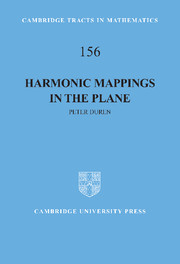22 results
Multiplicative Isometries and Isometric Zero-Divisors
-
- Journal:
- Canadian Journal of Mathematics / Volume 62 / Issue 5 / 01 October 2010
- Published online by Cambridge University Press:
- 20 November 2018, pp. 961-974
- Print publication:
- 01 October 2010
-
- Article
-
- You have access
- Export citation
OSCILLATION OF SOLUTIONS OF LINEAR DIFFERENTIAL EQUATIONS
- Part of
-
- Journal:
- Bulletin of the Australian Mathematical Society / Volume 79 / Issue 1 / February 2009
- Published online by Cambridge University Press:
- 09 February 2009, pp. 161-169
- Print publication:
- February 2009
-
- Article
-
- You have access
- Export citation
Schwarzian derivative criteria for valence of analytic and harmonic mappings
-
- Journal:
- Mathematical Proceedings of the Cambridge Philosophical Society / Volume 143 / Issue 2 / September 2007
- Published online by Cambridge University Press:
- 01 September 2007, pp. 473-486
- Print publication:
- September 2007
-
- Article
- Export citation
5 - Harmonic Univalent Functions
-
- Book:
- Harmonic Mappings in the Plane
- Published online:
- 15 September 2009
- Print publication:
- 29 March 2004, pp 78-88
-
- Chapter
- Export citation
7 - Mapping Problems
-
- Book:
- Harmonic Mappings in the Plane
- Published online:
- 15 September 2009
- Print publication:
- 29 March 2004, pp 111-135
-
- Chapter
- Export citation
10 - Curvature of Minimal Surfaces
-
- Book:
- Harmonic Mappings in the Plane
- Published online:
- 15 September 2009
- Print publication:
- 29 March 2004, pp 173-195
-
- Chapter
- Export citation
Contents
-
- Book:
- Harmonic Mappings in the Plane
- Published online:
- 15 September 2009
- Print publication:
- 29 March 2004, pp vii-x
-
- Chapter
- Export citation
8 - Additional Topics
-
- Book:
- Harmonic Mappings in the Plane
- Published online:
- 15 September 2009
- Print publication:
- 29 March 2004, pp 136-155
-
- Chapter
- Export citation
3 - Harmonic Mappings onto Convex Regions
-
- Book:
- Harmonic Mappings in the Plane
- Published online:
- 15 September 2009
- Print publication:
- 29 March 2004, pp 29-56
-
- Chapter
- Export citation
Appendix: Extremal Length
-
- Book:
- Harmonic Mappings in the Plane
- Published online:
- 15 September 2009
- Print publication:
- 29 March 2004, pp 196-200
-
- Chapter
- Export citation

Harmonic Mappings in the Plane
-
- Published online:
- 15 September 2009
- Print publication:
- 29 March 2004
2 - General Properties of Harmonic Mappings
-
- Book:
- Harmonic Mappings in the Plane
- Published online:
- 15 September 2009
- Print publication:
- 29 March 2004, pp 18-28
-
- Chapter
- Export citation
1 - Preliminaries
-
- Book:
- Harmonic Mappings in the Plane
- Published online:
- 15 September 2009
- Print publication:
- 29 March 2004, pp 1-17
-
- Chapter
- Export citation
Frontmatter
-
- Book:
- Harmonic Mappings in the Plane
- Published online:
- 15 September 2009
- Print publication:
- 29 March 2004, pp i-vi
-
- Chapter
- Export citation
4 - Harmonic Self-Mappings of the Disk
-
- Book:
- Harmonic Mappings in the Plane
- Published online:
- 15 September 2009
- Print publication:
- 29 March 2004, pp 57-77
-
- Chapter
- Export citation
6 - Extremal Problems
-
- Book:
- Harmonic Mappings in the Plane
- Published online:
- 15 September 2009
- Print publication:
- 29 March 2004, pp 89-110
-
- Chapter
- Export citation
References
-
- Book:
- Harmonic Mappings in the Plane
- Published online:
- 15 September 2009
- Print publication:
- 29 March 2004, pp 201-210
-
- Chapter
- Export citation
9 - Minimal Surfaces
-
- Book:
- Harmonic Mappings in the Plane
- Published online:
- 15 September 2009
- Print publication:
- 29 March 2004, pp 156-172
-
- Chapter
- Export citation
Index
-
- Book:
- Harmonic Mappings in the Plane
- Published online:
- 15 September 2009
- Print publication:
- 29 March 2004, pp 211-212
-
- Chapter
- Export citation
Preface
-
- Book:
- Harmonic Mappings in the Plane
- Published online:
- 15 September 2009
- Print publication:
- 29 March 2004, pp xi-xii
-
- Chapter
- Export citation

